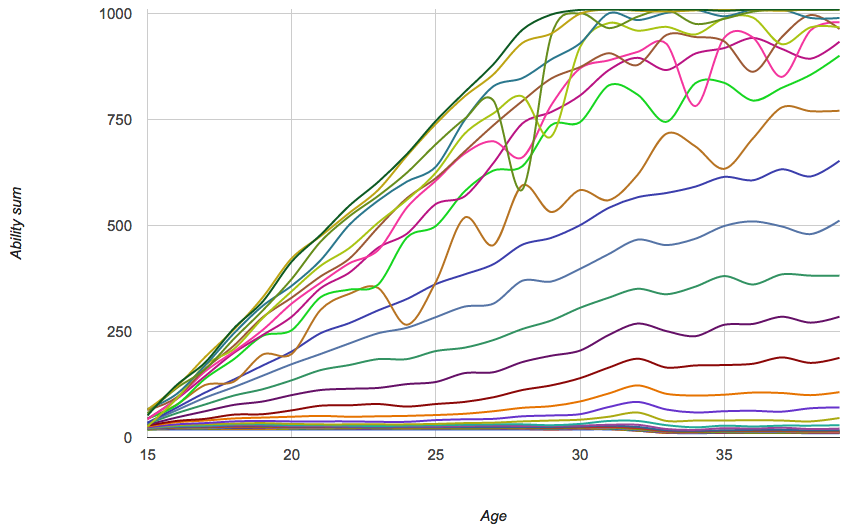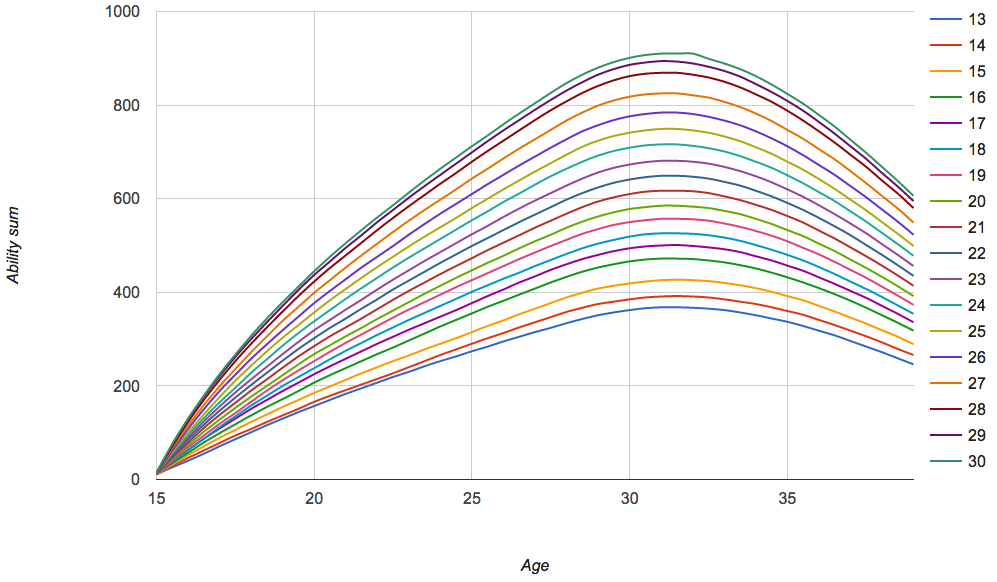
Rebalance: XP and age-related decline
I'd like to introduce the next step in Project Rebalance.
Since my last blog post about the rebalance, we've been collecting data, analysing and coding tools to help us simulate player careers using different parameters. A player in Virtual Manager has a lifespan of about 2 years real-time. Therefore we look to look far into the future in order to get a complete overview of where our balancing changes will take us.
Status as of today
We started by gathering statistics from the database, to get an overview of how far players of different potentials reach.
Each of the 30 lines in the graph represent the set of players with each of the different potentials between 1 and 30.
The upper 10 lines, which represent potentials 21-30 are very uneven. This is due to the fact that so incredibly few of them are drawn that a few outliers make the graph jump up and down. The lines for the rest of the potentials are much more even.
The fact each potential level is not even even distance apart is due to factors such as training facilities and unemployment. The bottom 10 or 12 potentials are almost never hired and therefore never trained - and almost all of the players in the top 10 potential levels are trained on the highest level training facility.
The graph illustrates one of the problems with player careers today: The best players can reach the ceiling of 1000 in total abilities and remain there for 10-12 years, depending on when they retire.
A career simulator
In order to get the ball rolling with the task of designing a new career progression, we started by building a career simulator. With that, we can let different players train for a whole lifetime from 15 years of age until 40, and thereby gain an overview of the effect of different changes.
TO begin with, we tried to recreate the situation as of today with simulated players, in order to fine-tune the simulator.
Players' career progressions depend highly on the managers' behaviours and priorities with regards to trades, training programmes, trainers, energy, boosts, moods, and the manager's absence etc. etc.
Therefore it's impossible to create a perfect simulation and we had to make a number of assumptions about all of these factors. In the end, we did manage to tune the numbers in such a way the the simulator's results were adequately close to the statistics we gathered.
With this tool in hand, we could then start to look at different solutions.
Increasing XP requirements to level up an ability
Do you remember when we renamed the training result units from % to xp earlier this year?
That small change now gives us some exciting options for designing new career progressions. Since we're no longer bound by the %-sign, a level-up in an ability no longer has to exactly 100 units.
So instead of changing how much xp you get each training, we can change how much xp it requires to level up an ability.
That means that if a player trains +100xp today, he still will after the rebalance.
On the drawing board right now, is a formula that starts at 50xp (to level up from 1 to 2) and ends at 200xp (to level up from 99 to 100). These number might still change, though.
Age-related decline of abilities
The age-related decline is the most fundamental change, and it is the one that has been discussed and wanted for years.
It will work something like this:
- Decline sets in when the player approaches an age around 28 to 30.
- The decline starts slowly and becomes faster the older the player gets.
- The most significant decline will hit the physical attributes: Speed, Acceleration and Stamina.
- Technical abilities will also decline a little, but not near as fast the the physical ones. This decline will be small enough that you can overcome it with training - at least in the beginning.
- Mental abilities (Leadership and Perseverance) will never decline. This means that you might consider keeping one of your old, experienced players around as a Captain, even though he's not as spritely as he used to be.
- One of the levels of the physio department will give you detailed insight in each player's decline.
Simulating the changes
So how will player careers look when they are born and trained under the new parameters?
When we run them through the career simulator, we get this result:
I've only included potentials 13 to 30 in the graph, since the smallest potentials aren't very interesting.
In this example, the player's decline starts when he turns 28, but in the beginning it's weak enough that you can overcome it with training.
Around 31 years, the player has reached his peak, and it's all downhill from there.
The greater the ability sum, the quicker they decline.
Notice that the best players are only near their peak for around 2 player years. It is in this relatively short period, that the clubs with ambitions of being at the absolute top need to get their hands on them.
The curves for the poorer players are quite a bit flatter, so clubs with lower ambitions don't need to stress out as much about changing them.
I haven't shown a graph of players' Ratings progressions, since that number is even more highly dependent on each manager's behaviour. It's impossible to construct a simulation that accurately matches every single manager's different priorities in their training programmes. Therefore, ability sum is cleaner number to examine. Even though players will be able to each 99 in Rating, it will have to be at the expense of other abilities, since no player in this example reaches the ability sum ceiling of 1000.
Later on in the process, I will be showing projections of Ratings as well, though.
The parameters in this simulation have not been set in stone. The point of this graph is to give us a overall picture of where we're headed.
That's because we still need to finish one very important part, which could potentially change everything...
The next step
In this post we've only been looking at what will happen to individual players with specific potentials.
But, in order to get the balance just right, the next step is to simulate a whole population of players in what will be the equivalent of 2 years real time.
That means that we'll have to simulate a progression where youth players are continually being drawn with the new potential distribution at a rate of 815,000 per year. All of these players will have to live an entire lifetime with training and retirement.
Not until we've simulated an entire generation from the day they are drawn as youth players until the day they retire, can we make any conclusions about how the new changes will affect the overall balance of the game.
After that, we can then adjust the parameters in the two changes above, and achieve the overall player distribution that we want.

 Bubbles,
Bubbles, 
